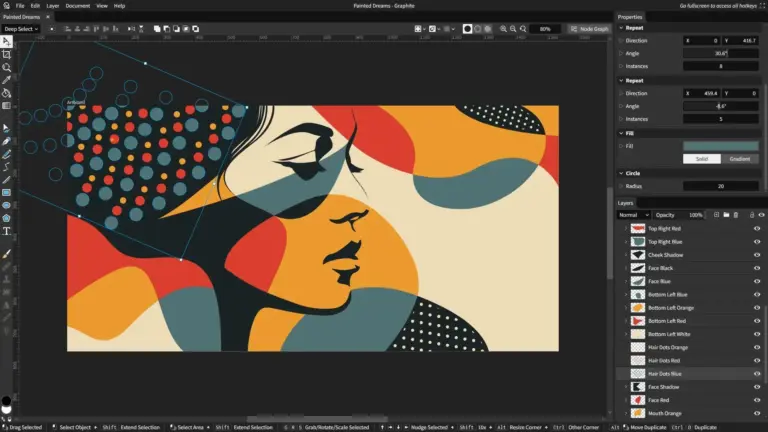Os desenvolvedores do Graphite divulgaram, neste sábado (20), as novidades da ferramenta trazidas neste mês de setembro. A mais recente atualização, que abrange o período de maio a setembro de 2025, marca a versão Alpha 4 do software e introduz mais de 300 mudanças significativas.
O projeto, que busca se consolidar como uma suíte criativa 2D em versões web, linux, Mac e Windows, com fluxo de trabalho não destrutivo, ainda está em fase de desenvolvimento alfa. Isso significa que não é recomendado usar em seu workflow de produção até que uma versão estável seja disponibilizada. Mas incentivamos testar, pois as funcionalidades estão sendo adicionadas e refinadas, e o feedback da comunidade é essencial.
Vamos detalhar os principais pontos desta atualização.
Mudança estrutural: Processamento de dados e renderização
A alteração mais profunda desta versão foi a refatoração do formato de dados e da tecnologia de renderização. Antes, o grafo de nós processava um item de cada vez (como uma única forma vetorial). Agora, o sistema foi redesenhado para processar listas de dados. Na prática, isso permite que operações como “repetir” ou “espalhar” gerem múltiplas formas vetoriais independentes que ainda podem ser manipuladas individualmente por nós subsequentes. Isso resolve uma limitação anterior, onde tais operações criavam um “grupo” de dados menos flexível.
Atenção: Devido a essa mudança fundamental, arquivos criados em versões anteriores que utilizam transformações podem apresentar um comportamento visual diferente. O novo motor pode recalcular os dados de forma distinta, exigindo ajustes manuais para restaurar a aparência original.
Melhorias nas ferramentas e interface
Gerenciamento de Camadas e Traços:
Você está gostando do conteúdo? Que tal apoiar a equipe do Cine Linux com o valor de um cafezinho?
- Cor de Fundo: Uma camada agora pode ser preenchida diretamente com uma cor sólida. Essa funcionalidade é ideal para estabelecer um plano de fundo para o canvas infinito sem a necessidade de criar um objeto retangular gigante, facilitando o início de trabalhos de design ou arte conceitual sobre uma base colorida.
- Máscaras de Recorte (Clipping): Foi implementada a capacidade de criar máscaras de recorte de forma intuitiva. Ao segurar
Alte clicar na borda entre duas camadas, a camada superior se torna visível apenas nos limites da inferior. É um recurso essencial para texturizar formas, confinar pinceladas a uma área específica ou criar efeitos de composição complexos. - Alinhamento e Ordem do Traço: O traçado (stroke) recebeu mais opções de controle. Agora ele pode ser alinhado pelo centro da borda, por dentro ou por fora da forma, oferecendo a precisão necessária para design de ícones e trabalhos técnicos. Também foi adicionada a opção de renderizar o traçado atrás do preenchimento, garantindo que o preenchimento da forma nunca seja obscurecido pela espessura da linha.
Painel de Dados e Grafo de Nós:
- Novo Painel de Dados: O antigo painel de planilha foi substituído por um inspetor de dados completo. Ele permite “mergulhar” nos dados brutos de qualquer camada ou nó, exibindo em tempo real tabelas com coordenadas de pontos, valores de cor ou matrizes de transformação. É uma ferramenta poderosa para depurar efeitos procedurais complexos e entender exatamente o que está acontecendo em cada etapa do grafo.
- Usabilidade do Grafo: A organização dos nós foi aprimorada com uma melhor categorização para facilitar a busca. A manipulação também foi simplificada com gestos intuitivos: agora é possível arrastar um nó sobre uma conexão para inseri-lo automaticamente no fluxo ou sacudi-lo para desconectá-lo.
- Conversão Automática de Tipos: O sistema agora converte automaticamente diferentes tipos numéricos (como inteiros e ponto flutuante). Isso remove um ponto de atrito comum em sistemas nodais, permitindo que o artista se concentre no resultado criativo em vez de se preocupar com a compatibilidade técnica entre os parâmetros dos nós.
Ferramentas de Desenho Vetorial:
- Ferramenta Caminho (Path Tool): Recebeu diversas melhorias inspiradas em softwares 3D, como o Blender. O atalho
GGpermite deslizar um ponto ao longo de suas arestas conectadas, preservando a silhueta da curva. Foi adicionado um modo de edição de segmentos (com atalhosReSpara rotacionar e escalar), e o uso doTabagora alterna rapidamente entre a edição de caminhos e a seleção de objetos. - Ferramenta Forma (Shape Tool): A antiga ferramenta Polígono foi unificada com as ferramentas de Linha, Retângulo e Elipse. Agora, ela permite criar diversas primitivas, como arcos (com controles de gizmo na tela para ajuste interativo), espirais e grades. Nota: A renderização de grades ainda apresenta bugs visuais devido a limitações no suporte a malhas vetoriais complexas.
- Edição de Geometria: Operações básicas e essenciais como copiar, colar e duplicar geometria agora estão disponíveis diretamente na ferramenta Caminho, agilizando o fluxo de trabalho de edição vetorial.
Novos Nós e Melhorias de Desempenho
Uma série de novos nós foi adicionada para expandir as capacidades do editor procedural:
- Nós de Dados:
Index(para filtrar um item específico de uma lista),Count Elements(para contar itens) ePath Length(para medir o comprimento de um caminho). - Nós de Caminho:
Cut Path(corta um caminho em um ponto) eCut Segments(separa cada segmento em um caminho individual). Esses nós são blocos de construção para efeitos de desconstrução, como animar uma linha se desenhando ou aplicar cores diferentes a cada segmento de uma forma. - Nó de Texto: Agora permite separar cada glifo (letra) em um elemento individual, abrindo a possibilidade de animar ou estilizar letras de uma palavra de forma independente.
- Looping Aninhado: O nó
Instance Repeatagora suporta um parâmetro de “nível de loop”, permitindo a criação de laços aninhados. Com isso, é possível gerar grades 2D de objetos e variar suas propriedades com base tanto no índice da linha quanto da coluna.
O desempenho geral do software foi um foco importante. A navegação (pan) em documentos complexos está mais suave. Os algoritmos para operações vetoriais foram substituídos por implementações centenas de vezes mais rápidas. A manipulação de imagens raster de alta resolução também foi otimizada, apresentando agora uma resposta fluida e próxima do tempo real, eliminando a latência que pode interromper o fluxo criativo.
Próximos passos rumo ao beta
A equipe continua trabalhando para estabilizar o software e adicionar funcionalidades essenciais. De acordo com o roadmap e o vídeo de apresentação, os próximos focos incluem:
- Aplicação Nativa para Desktop: Uma versão nativa escrita em Rust, com previsão de lançamento para o final do ano. Rodando de forma independente, sem um navegador, ela poderá aproveitar melhor o hardware do sistema, resultando em maior desempenho e estabilidade.
- Renderização Acelerada por GPU: A implementação da renderização de imagens raster acelerada por hardware está próxima de ser finalizada.
- Painel de Animação: Um painel dedicado à animação por keyframes está planejado, expandindo as atuais capacidades de animação procedural e tornando o Graphite uma ferramenta mais completa para motion graphics.
Vantagens e desvantagens para o profissional de cinema e audiovisual
Analisando esta atualização sob a ótica de motion designers, animadores e outros profissionais da área, podemos destacar:
Vantagens
- Potencial Elevado para Motion Graphics Procedural: A capacidade de manipular listas de dados, combinada com o looping aninhado e nós como
Separate Subpaths, abre um leque imenso para a criação de animações complexas e data-driven. É possível, por exemplo, criar sistemas de partículas, replicadores avançados e animações tipográficas onde cada letra se comporta de forma independente, tudo de maneira não destrutiva. - Fluxo de Trabalho Mais Fluido em Projetos Pesados: As melhorias de desempenho são um ganho direto. Projetos de audiovisual frequentemente envolvem logos vetoriais complexos ou a manipulação de texturas e imagens de fundo em alta resolução. A resposta em tempo real significa menos tempo de espera e um processo criativo mais interativo.
- Sinergia com o Ecossistema Open Source: A adoção de atalhos e conceitos familiares para usuários do Blender (
GG,Tab) reduz a curva de aprendizado e melhora a integração do Graphite no pipeline de ferramentas de código aberto que muitos profissionais no Linux já utilizam. - Ferramentas de Tipografia Mais Robustas: Para a criação de vinhetas, legendas e créditos, o novo motor de tipografia com alinhamento justificado e controles por glifo é uma adição valiosa que confere um acabamento mais profissional ao texto.
Desvantagens
A desvantagem do Graphite por enquanto não pode ser mensurada por se tratar de um software Alpha e não queremos queimar o projeto antes da largada. A desvantagem que podemos colocar por enquanto é que o software ainda não pode ser considerado para um workflow de produção até que uma versão estável seja lançada.
Agradecimento aos desenvolvedores
É impossível não reconhecer a ambição e a dedicação da equipe de desenvolvimento do Graphite. O progresso demonstrado em poucos meses é notável, e a transparência com que compartilham os desafios e os próximos passos é um exemplo para a comunidade de software livre. Eles não estão apenas construindo uma ferramenta; estão pavimentando um caminho para um ecossistema criativo mais robusto, aberto e poderoso na plataforma Linux. Nossos parabéns a todos os desenvolvedores e contribuidores envolvidos.
Você gostou do conteúdo? Que tal apoiar a equipe do Cine Linux com o valor de um cafezinho?



